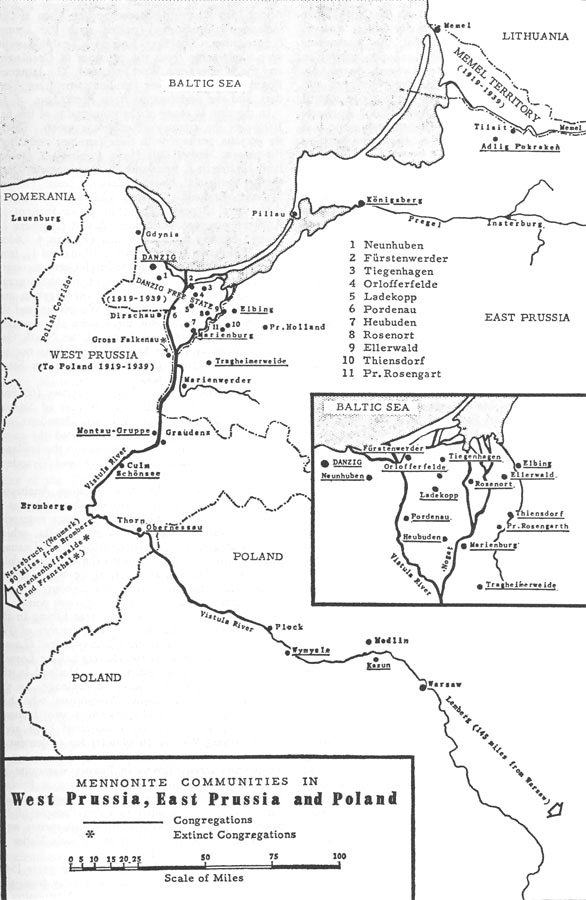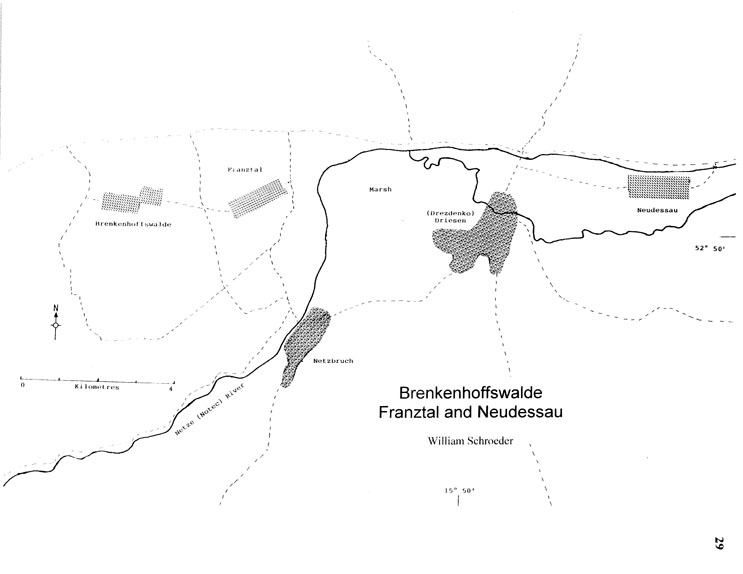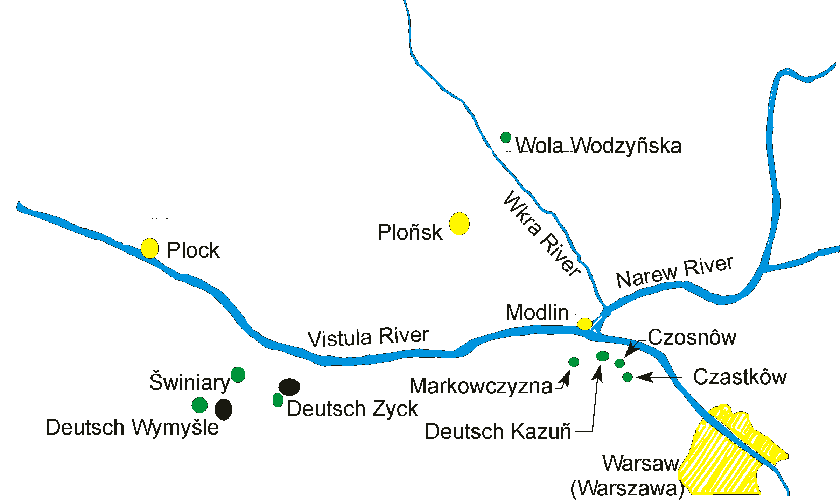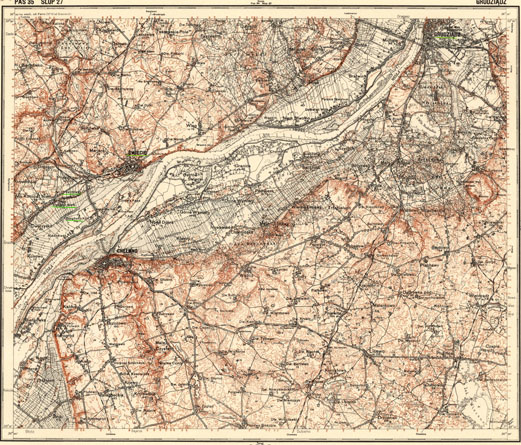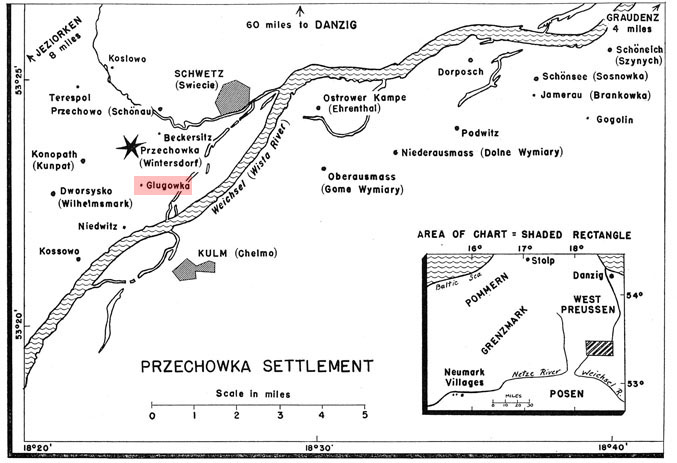Schwetzer Niederung
&
Neumark Netzebruch
Benjamin Penner
&
Maria Kurtzhalz
I. From David Karber Family Book
"In 1765 Frederick the Great permitted 35 families expelled by Polish noblemen from the Culm lowlands (Przechovka) to settle at Brenkenhoffswalde and Franztal in the province of Brandenburg, Germany, some 100 miles to the west. They agreed to drain the lowlands and to cut down the trees that had grown over the previously tilled land. In return, they were granted religious freedom and exemption from military service. It was here in Brenkenhoffswalde that Benjamin Penner, Henrietta (Penner) Karber's father, was born on November 17, 1807. After the spector of universal military training arose during the Napoleonic Wars (1805-1814), a full-fledged migration occurred from this area to Deutsch Wmysle near Warsaw in Russian Poland during the years 1818-24. Deutsch Wymysle had been founded in 1762 by emigrants who had earlier left Przechovka, and thus the new residents were reunited with descendants of their former villagers. Among the the family names which made this move was that of Penner. In all likelihood Benjamin Penner's family was one of them. (He would have been between 11 and 17 years of age at the time.) Living in this area was a family by the name of Kurtzhalz, with a daughter Maria. Her mother had first been married to a Ratzlaff (a name common among the Mennonites from Przechovka), but he was such a lazy man that she divorced him. Since she could no longer be a Mennonite, she married a German Lutheran named Kurtzhalz. Their daughter Maria was born on July 11, 1814 at Glugofsky, West Prussia (location unknown). At some point in her childhood, the Kurtzhalz family moved to the Deutsch Wymysle area, where Maria met Benjamin Penner. They became acquainted, fell in love, and were married on May 14, 1832 (he was 24 years old, she was 17)." [ The David and Henrietta Karber Family]
"She was born the 11th of July, 1814, in the village of Glugofka, West Prussia, and died on the 25th of Janurary, 1889" [Zionsbote, 8 Feb 1899, p.3, "Oklahoma, Isabella, Woods Co, 25 Jan, 1899."]
II. Maps
Glugofka/Glugofsy was a village in the lowlands around the town of Schwetz [Polish: Świecie], whose Mennonite inhabitants were members of the Przechovka congregation.
III. Historical and Regional Context
***Click on titles to read***
From the Mennonite Encylcopedia (www.gameo.org):
Schwetzer Niederung (Kuyavian-Pomeranian Voivodship, Poland)
Schwetzer Niederung (Lowlands near Schwetz), a district (starostei) on the Vistula in West Prussia, until 1772 belonging to Poland. Dutch colonists reclaimed this swampy area in the 16th and 17th centuries. In the Schwetzer Niederung were found the villages of Deutsch-Westfalen, Brattwin, Schönau, Kleinsee (Jeziorka), Neunhuben, Wintersdorf, Christfelde, and Kossovo. Wintersdorf (Przechovka), was the first Mennonite settlement (ca. 1540). About 1650 there was a considerable number of Mennonites in all these villages, and some villages were completely Mennonite. Until the early 18th century the Mennonites enjoyed many privileges such as the freedom to organize their own schools, and exemption from military taxes and quartering soldiers. By their able land-draining and their skillful farming the Schwetzer Niederung be came very prosperous, but repeated floods, exploitation by the rulers and officials, and restrictive economic regulations caused the Mennonites to move away from 1765 to 1850 (to Brenkenhoffswalde and Deutsch-Wymysle); by 1850 all the Mennonites had left this area.
Graudenz (Kuyavian-Pomeranian Voivodeship, Poland)
After the devastating floods of the Vistula River about 1560, large areas of the territory of Graudenz were depopulated. This stricken territory was then largely taken over by Dutch settlers, usually Mennonites, who were granted the privileges of freedom of religion, their own schools, and transporting their products on the Vistula free of taxes. In the 17th century Mennonites predominated in the following villages: Parsken, Kommerau, Klein-Lubin, and Dragass; they were very numerous in the villages of Klein-Wolz, Tresch, Gross-Lubin, and Klein-Lubin.
In Graudenz and its vicinity there were until 1945 numerous Mennonites, especially in the congregations of Montau, Gruppe, and Schönsee. In the "Consignation" of all Mennonite families living in "West Prussia" in 1789 (thus outside the city of Danzig and the region of Thorn, both of which were ceded to Prussia in 1793 in the second partition of Poland).
Graudenz was the scene of the memorable meeting between Frederick William III of Prussia and Abraham Nickel of Jamrau, the deacon at Culm (Schönsee), 8 October 1806 in the "gouverneur" house, later a school, Nonnenstrasse 5 at the Luisenbrücke
Montau (Kuyavian-Pomeranian Voivodship, Poland)
Montau (Polish Matawy), a Mennonite congregation in former West Prussia, near Neuenburg (Schwetz district). According to documents preserved in Danzig (now Gdansk) this settlement had existed since 1568, for on 2 February 1568 a number of Dutch Mennonites had moved in from the Danzig Werder—Thomas and Peter Jansen, Leonhard von Rho (garbled; probably Leenaert van Rhoon), Bernhard von Baygen (Berent van Bargen), Andreas (Andries) Unrau, and their companions and relatives—and concluded a rental contract with Hans Dulzky of Roggenhausen; it included the villages of Montau and Sanskau, an area of 50 hooves. The further settlement of the Schwetz-Neuenburg lowlands apparently radiated from here. The documents also indicated the Dutch origin of the settlers. Other evidence of this origin was seen in the architecture and in the Dutch Bibles preserved in some of these homes. Dutch was the language used in preaching until the 18th century. Later, when the Mennonites spread over the entire lowland, a subsidiary church was built at Obergruppe in 1776.
In course of the 16th and 17th centuries there were several additional immigrations from Holland. The Montau group was the first to settle near the left bank of the Vistula River, and gradually spread out over a wide area; as early as 1598 a number of Mennonites from Montau settled near Sanskau to begin the cultivation of this area. Others settled at Gruppe, Deutsch-Westphalen, Gross-Lubin, Neunhuben, Dragass, all in the neighborhood of Montau. In the late 18th century some of its members moved to Brenkenhoffswalde and to Deutsch-Kazun. The area of Montau was in the 17th and 18th centuries struck by various calamities. About 1620 the Mennonites had some difficulty with the governors, but in 1623 obtained freedom from military service and quartering. About 1657 during the Swedish-Prussian war Mennonite property was severely damaged by the passing armies; the floods of the Vistula repeatedly damaged the fields and the houses, particularly in 1677, when a number of farms were destroyed and many people and cattle perished, and many fields were ruined by the sand washed over them. A few years later they suffered a total crop failure. In 1727 the passing armies (Polish, Saxon, Swedish, Russian) plundered the farms to such an extent that they had to sell some of their land to pay their taxes. After 1772, when this area was occupied by Prussia, conditions were somewhat improved; but during the Napoleonic wars (1806-1815) the congregation again suffered severely. In many of their tribulations the Montau Mennonites were financially supported by the Dutch Mennonites.
In the 16th-18th centuries the Montau congregation belonged to the Frisian Mennonite branch. At a conference held in Montau in 1568 delegates from Danzig, Elbing, the "Kleine Marienburger Werder," Montau, and Thorn resolved to side with the Frisian party in the Netherlands. The first elder was very probably Hilchen Schmidt (Hylke Smit), who was commissioned by the Haarlem congregation in 1588 to depose Quiryn van der Meulen from the office of elder in Danzig.
For centuries the congregation held to the old doctrines and practices, including nonresistance. The North German law issued on 9 November 1867, threatening to deprive the Mennonites of their old privilege of freedom of military service also confused the congregation in Montau. After much correspondence and several audiences at Berlin, the church council accepted a new church constitution drawn up by Elder Peter Bartel, which permitted members to accept noncombatant service, as offered by the Order of Cabinet of 3 March 1868, but threatened to excommunicate those choosing military service; this was, however, never carried out. The question of military service caused the Obergruppe congregation to split off from the Montau church in 1869; the new group refused to tolerate soldiers as members, whereas the Montau congregation did not exclude such members. In 1920 the breach was healed, and the combined brotherhood was then called the Montau-Gruppe congregation.
Przechovka (Kuyavian-Pomeranian Voivodeship, Poland)
Przechovka (Przechowka, German, Wintersdorf), West Prussia (now Poland), was formerly the seat of an Old Flemish congregation, the mother congregation of the Brenkenhoffswalde congregation in the Netzebruch and of Alexanderwohl and Gnadenfeld, the leading congregations in the Molotschna Mennonite settlement. It was situated inland from the villages of Deutsch-Konopath and Divorczieka (German, Wilhelmsmark) and along the Vistula River with the villages of Glugovka, Kossovo, and Christkovo (German, Christfelde), southwest of Schwetz with Ostrov (German, Ehrenthal) up the Vistula in the Klein-Schwetz marsh, south of the Frisian communities of Montau-Gruppe and Schönsee. Przechovka and Divorczieska were royal villages, Deutsch-Konopath, Kossovo, and Christkovo noble villages, Glugovka part royal and part noble. The settlements are thought to have originated about 1540; in 1661 they were a part of the Groningen Old Flemish Sociëteit, which held most tenaciously to the old traditions. In the 18th century there were settlements of Old Flemish to the northwest in the noble villages of Jeziorka (German, Kleinsee), straight north in Tuchel, and northeast across the Vistula in Schönsee, Posterwolde, Horst, Ausmass, Jamerau, and Dorposch.
The estate of Przechovka was originally sold to five Mennonites from the Netherlands by the heirs of a Polish nobleman; these settlers attracted other Anabaptists, so that the village community finally embraced 15 home sites. The first contract of lease was granted to the village in 1642 for 50 years. In 1653 there was an association of Dutch inhabitants for the support of the schoolteacher, the burial of members of other faiths; in 1668 a "Manist Johannes" touched his breast as affirmation instead of an oath. The privilege granted by John II Kasimir was confirmed a number of times; on 9 February 1672, it was confirmed expressly for Przechovka, Kossovo, and Christkovo.
Under the leadership of Peter Wedel and Heinrich Buller most of the Mennonites left in the Schwetz area emigrated to the Molotschna Mennonite settlement in Russia in 1819-1820 and 1823-1824, and founded the Alexanderwohl congregation. Concerning the end of the congregation Stobbe reports: "The meetinghouse was in the present school yard. . . . In 1832, when the town of Przechovka built its own school and wanted to rebuild the Mennonite meetinghouse for that purpose, the few remaining Mennonites opposed the move and sold it to be dismantled. What happened to the meetinghouse cannot be ascertained, since the records of the town were destroyed by a fire in 1857. The last elder was a Richart and lived in Deutsch-Konopath. The congregation that at the end of the 18th century had about 300 members was extinct by about 1830. The few remaining old Flemish united with the Frisians in 1849."
Schönsee (Pomeranian Voivodeship, Poland)
Schönsee (Polish, Sosnovka), a village in Poland, from 1772 until 1919 belonging to West Prussia, Germany, situated ten miles north of Culm about two miles from the right bank of the Vistula River, where Mennonites from the Netherlands settled as early as 1553 to reclaim and drain the swampy lands along the Vistula, being the first Mennonite settlement in the Culm region. The first land lease is lost, but a second one, of 1594, between the city of Culm, to which this territory belonged, and the farmers, still exists. In this and following leases only farming was allowed to the settlers; no handicrafts were permitted except weaving, tailoring, and shoemaking for private use. They were allowed to fish in the Vistula. The settlers, who lived at Schönsee and also in the surrounding villages and hamlets such as Jamerau, Dorposch, Lunau, and Schöneich, were explicitly granted the privilege of free exercise of their religion, including teaching in schools. The following Mennonite families are named in the land leases in 1695 and after: Unrau (Unruh), Siefert (Siebert), Hube(?), Block, Voth (Foth), Funk, Jans (Jantz), Buller, Köhn, Sperling, Stephan (Stevens, Steffens), Wilhelm (Willems), Boltz (Bolt), Stob (Stobbe), Tomasche (Thomsen), Meister, Decker, Penner, Brümmer(?), Mentz, Schümann (Schoman), Frantz, Abraham (Abrams), Pödker (Boetscher), Voutsche(?), Siedau(?), and from 1725 also Nickel, Bartel, Schröder, Nachtigal, Weitgraff (Weidegraf), Pancratz, Arndt (Arentsz), Eckert (Eggert), and Plener (Plenert). Besides these there are found in the list drawn up by Elder Hendrik Berents in 1719 the names of Schellenberg, Isaack, and Riggers (Richert). Since a number of these names are not Dutch-Frisian, other settlers must in the meantime have joined the original settlers.
As early as about 1570 there were two Mennonite congregations at Schönsee, one Flemish, whose meetinghouse was called "die kleine Schule" (small school), which sided with the Groningen Old Flemish, and one Frisian (also called Waterlander), whose meetinghouse, built in 1618, was called "die grosse Schule" (large school). They are small and very plain buildings (pictures in Siedlungswerk taken in 1940-41).
Concerning the early history of the Mennonites of Schönsee there is not much information. Social and religious development seems to have been favorable in the 16th and 17th centuries. Sometimes they were struck by calamities like floods and crop failures, but their tenacity and energy, and aid from their benevolent landlords, the city magistrates of Culm, easily overcame their blows. Both congregations of Schönsee were small in membership; the Frisians, concerning whom there is no further information, formed the larger one; in 1719 the Flemish numbered 48 baptized members. This Old Flemish group then belonged to the same congregation as Przechovka (Wintersdorf) and Konopath on the left bank of the Vistula in the territory of Schwetz, and Posterwolt on the right bank. Although Schönsee was a part of this congregation, it obviously had its own preachers by this time. In 1760 a separation was made for practical reasons.
In 1765 a number of Old Flemish Mennonites from Przechovka and Schönsee moved to Brenkenhoffswalde and Franztal in the Neumark; others emigrated to Deutsch-Kazun about 1780 and still others to Volhynia in the early 19th century. These emigrations appreciably decreased particularly the number of Flemish Mennonites in this area.
On 12 October 1849, the small Old Flemish congregation of Schönsee, then numbering 39 souls, merged with the Frisian congregation. The Flemish meetinghouse was abandoned; the old Frisian meetinghouse of 1618, somewhat remodeled, was used until 1945.
Brenkenhoffswalde and Franztal (Brandenburg, Germany)
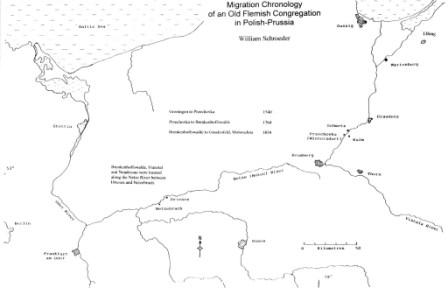
|
Click photo for full size [4] |
Brenkenhoffswalde (Polish: Błotnica) and Franztal (Polish: Głęboczek), villages in the Netzebruch near Driesen (Polish: Drezdenko) in Neumark, province of Brandenburg, Germany (after 1945 located in Strzelce-Drezdenko County, Lubusz Voivodeship, Poland). In 1765 Frederick the Great, who had given Councilor Brenkenhoff charge of settling the marshy Netzebruch, permitted 35 Mennonite families expelled by Polish noblemen from the Culm lowlands to settle here; of these, 16 families with 95 persons were allocated in Brenkenhoffswalde and 19 families with 97 persons in the adjacent Franztal. They at once formed the Brenkenhoffswalde Mennonite congregation, which existed until 1834. The king gave them land and furnished lumber; until 1771 they were not taxed, and by a charter drawn up by the king himself they were "completely free from military service and conscription." They belonged to the "Groninger Mennonites," or Groninger Old Flemish. This explains why they had not joined the larger Frisian congregation in the Culm lowlands at Schönsee, but had formed a congregation of their own with some scattered members at Thorn and Schwetz. They maintained contact and communion with these after they had come to Brenkenhoffswalde. According to the Dutch Naamlijsten, preachers of this congregation were Andreas Voet (Foth), Ernst Voet (Foth), Peter Jansz, Jacob Schmidt, and Peter Isaack.
The history of the church offers much that is of interest. A letter written by the church board to Harm Scholtens at Groningen (Inv. Arch. Amst. dated 22 July 1766, contains interesting particulars concerning the young congregation, which had already begun to build a meetinghouse. In 1788 the Lutheran teacher Wilhelm Lange of Brenkenhoffswalde, who had been appointed to the position by the government, asked permission of the authorities to transfer to the Mennonite faith, since he had grown up and been educated among Mennonites and was inwardly bound to them. On 24 October 1788 he received permission to do so, on condition that his obligations to the state and his duties as a citizen would not suffer. Wilhelm Lange became a respected and influential member; in 1802 he was chosen preacher, and in 1810 elder, which office he still held when the congregation emigrated to Russia in 1834. In 1833 Lange had sent a petition to the Tsar of Russia in the name of 40 families of Brenkenhoffswalde and Franztal to permit their immigration into Russia after permission to emigrate had been granted in 1828 to a certain Bengs of Brenkenhoffswalde by the government in Frankfurt an der Oder. It is probably to be assumed that the Mennonites in the Netzebruch did not see any possibility of acquiring more land, and therefore turned their attention to Russia, where most of the Groninger Mennonites from Culm and Schwetz had already gone. In 1823 there had been a small remnant of these families in Przechowo and Konopath near Schwetz, under the preacher Jakob Ratzlaff; but these also emigrated in 1824 to Alexanderwohl and other locations in South Russia.
Lange and his group received information on 10 January 1834 through the Russian consulate in Danzig, that the tsar would permit immigration on the following conditions: (1) presentation of a permit from the Prussian government to emigrate; (2) only families having at least five members would be admitted; (3) a sum of 800 rubles was to be deposited, which would be returned when they arrived. In that year the 40 families emigrated and found a hospitable reception in Alexanderwohl, but then founded the colony and church of Gnadenfeld. The Mennonite church at Brenkenhoffswalde was thereby dissolved. The few remaining joined the state church, including their teacher Peter Janz, who later became a Protestant preacher.
From www.holland.org.pl
BRENKENHOFFSWELDE-FRANZTAL
Current Polish Name: BŁOTNICA - GŁĘBOCZEK, district: Stare Kurowo, province: lubuskie.
1. BRENKENHOFFSWELDE-FRANZTAL
2. Flemish community.
3. The foundation of community took place in 1765, when 35 Mennonite families moved from their settlements in Przechówka and Jeziorka to Nowa Marchia, in order to reclaim the floodlands on the Warta and Noteć rivers. Gradually they settled several villages in the neighbourhood of Gorzów, which were gathered around Błotnica i Głęboczek. Initially their religious meetings took place in private houses. With the passing of time the available places became too small. They needed to raise their own house of prayer. The land for the building was handed without charge by the government. The funds for building were given by Mennonites from Prussia and Netherlands. On Nov. 8, 1778 the first service was performed in hewly raised building in Błotnica. In 1787, the residents of Głęboczek built their house of prayer as well, thanks to the donations of Mennonites from Prussia and Netherlands. The development of Mennonite community in Nowa Marchia was blocked in 1831, when Friedrich Wilhelm III withdrew all former privileges of Mennonites. The migration to the territories of Russia began, which ended with abandoning this region by last families in 1834. The houses of prayer were being used for some time as protestant churches, but finally they were demolished.
4. There are no data connected with appearance and form of the buildings. It is known that they shared space with schools. They must have been wooden, similar in shape to those of Jeziorka or Przechówka.
5. - A. Hänseler, Mennoniten im Netzebruch, Mennonitische Blätter, 1928, pp. 90-92.
- Mennonite Encyklopedia, op. cit., Vol. 1, pp. 416-417 i Vol. 3, pp. 844-845.
- B.H. Unruch, Die Mennoniten in der Neumark, Gemeinde - Kallendar, 1941, pp. 58-76.
IV. Other Penner Surname Data
***Click on titles to read***
The Praestations-Tabellen of Brenkenhofswalde and Franztal, Amt Driesen, Brandenburg Province in Prussia: 1826, Adalbert Goertz.
"Since the church records for the Neumark Mennonite church of Brenkenhofswalde and Franztal are lost, these tax tables together with the mortgage records of the Driesen court are the only source which may shed some light on the Neumark Mennonite families prior to their emigration to Russia and Poland in 1834." [2]
There are no Penners in the Neumark in 1826.
Mennonite settlers in the Neumark, Brandenburg (1767/1778) Adalbert Goertz
Table 5: Zinsregister der Colonie Neu-Dessau
vom 24.9.1778
29. Heinrich Penner 37 Morgen, 120 Ruten (square Ruten, acreage)
[3]
Court Records from the Grund- and Hypotheken-Acten of Neu Dessau, Amt Driesen, Neumark Erbzinsguth Neu-Dessau, Kreis Friedeberg, Brandenburg, Adalbert Goertz.
Signatur 1075 , PT Gut Nr.19 A , 1788 - 1922
Grund- and Hypotheken Acten of Royal Justiz Amts Driesen of plot Nr.19 A Erbzinsguth of 32 Morgen.
Band II Blatt 121 No.36
Besitzer: Daniel Schmidt
2.Ernst Heinrich Schumann, S.70
3.Die verehel......Krueger geb.Schumann
4.Eigenthümer Gustav Penner P.22
Der Landwirt Franz Penner
Signatur 1079 , PT Gut Nr.27 A , 1800-1881
Grund- and Hypotheken Acten of Royal Land- and Stadtgerichts Driesen of plot Nr.27a of 19 Morgen 135 Ruthen Erbzinsguth
Possessor: Wilhelm Zweiger
4.Carl Brüggemann
5.Johann Friedrich Veit
Dem Grundstück Nr.46 (früher 25) zugeschrieben
Fol.1, (page 11)
"Kund und zu wissen sey hiermit, dass zwischen dem Mennonisten und Einwohner Jacob Voot zu Neu Dessau an einem, und die beiden Einwohner Christian Dittmann und Johann Penner, am anderen Theile, nachfolgender unwiederruftlicher Kauf, wohlbedächtig untereinander verabredet und beschlossen worden. Es verkaufet nehmlich gedachter Verkäufer sein zu Neu Dessau zwischen dem Einwohner Christian Dittmann und dem Mennonisten Jacob Voot belegenes Erbzinsguth mit denen darauf befindlichen Gebäuden, Landung, Gärten und Wiesenrechten und Gerechtigkeiten, mit der Bestimmung, dass der Mennonist Johann Penner die grosse Stube und den halben Haus Flor nebst den alten Kuhstall nächst bey dem neuen Gebäude, und der Einwohner Christian Dittmann die kleine Stube insgleichen den halben Haus Flor und das alte Wohnhaus über den Forell Graben an den Wall behalten, und die Gräntze, welche durch die Theilung des Guths veruhrsacht und benöthigt ist, machen zum ersten Mahl beyde gedachte Käufer zu gleichen Theile in völligem Stande, und weiter in der Folge, dem Mennonisten Johann Penner zur Unterhaltung verbleibe, um und vor 2200 Rthl schreibe zwey Tausend und zwey Hundert Reichsthaler
(page 12)
in Pr.Courand Erb- und Eigenthümlich. Auf das Kaufgeld haben die beyden Käufer bereits an den Verkäufer bey Verabredung des Handels 1800 rth, der Einwohner Dittmann aber allein 1000 rth und der Mennonist Johann Penner 800 rth baar bezahlt, worüber ich die beyde Käufer quittire. Ein hundert Reichsthaler aber wolle der Dittmann annoch folglich bey der gerichtlichen Verschreibung noch bezahlen.
Die übrige 300 rth wolle der Verkäufer dem Mennonisten Johann Penner in das Erbzinsguth zu vier pro cent stehen lassen. Weiter ist bey der Verabredung des Handels nichts zu erinnern gefunden, bitten nur gantz untertänigst ein hochwohllöbliches Justiz Amt zu Driesen um eine allergnädigste gerichtliche Verschreibung aus zu fertigen.
Geschehen Neu Dessau d.28.ten Juny 1800.
Jacob Voot Verkäufer
Christian Dittmann und
Johann Penner, Käuferen."
(page 13)
(King Friedrich Wilhelm approves purchase on 14 May 1800, the administration informs the parties on 18 June)
König Friedrich Wilhelm gibt Kaufgenehmigung d.14.May 1800.
Preuss.Neumärk. Kriegs- und Domainen Kammer benachricht die Parteien am 18.Juny.
1) Christian Dittmann vom Netzwall bis zur alten Netze 18 M 160 R Magdeburgisch (2)
an Vorland 174 R
2) Johann Penner dito 18 M 160 R
an Vorland 174 R
Summa 39 M 128 R
page 15-17 lists the original sales contract; Jacob Voot and Christian Dittmann sign with xxx, followed by signatures "in fidem" of their legal councils.
Vermessen und eingetheilet d.18.Juny 1800 durch Werder.
Maastab von 160 Rheinländische Decimal Ruten."
(2) 1 Magdeburger Morgen = 180 Quadrat-Ruten = 2553 qmeter
Signatur 5878 , PT Gut Nr.8a , 1796 - 1924
Grund- and Hypotheken Acten of Royal (deleted:Land- und Stadt) Amts-Gerichts Driesen of plot Nr.8a Erbzinsguth
Possessor: Johann Seradde Wittwe geb.Johan....
Johann Carl Wilhelm Henke
Gastwirth Gustav Penner, P.22
Wilhelm Kasper K.492
der Eigenthümer Hermann Julius Gustav Kühl zu Neu Dessau K.588
Witwe Bertha Kühl geb.Bengson in Neu Dessau
(followed by oldest contract of 1796 from Gottfried Bult to Johann Ritter)
[4]
Przechowka Church Record
| Individual # |
Name |
Father # |
|
Married who(#), resided |
Died |
| 1160 |
Henrich Penner |
XIII |
Came from the low-lands where he joined the Neumark congrgation, was chosen and later installed as deacon. |
|
|
| 1161 |
Stiencke Pener |
1160 |
Died in the low-lands |
557, in Neudesau |
|
| 1162 |
Peter Pener |
1160 |
|
839, in Brenkenhofs Walde |
|
| 1163 |
Liscke Peners |
1160 |
|
|
|
| 1173 |
Elscke Peners |
1160 |
|
|
|
| 1174 |
Hans Pener |
1160 |
|
|
|
| 1175 |
Jacob Peners |
1160 |
|
|
|
| 1176 |
Daniel Peners |
1160 |
|
|
|
| |
|
|
|
|
|
| 557 |
Adam Bethcke |
|
Was a Catholic, a weaver journeyman, living in Neumark; became a member of our congregation. |
2nd marriage to Efcke Isaacs, in Neu Dessau |
1788 |
| 839 |
Hans Schmidt |
|
He was elected to the ministry July 22, 1792. |
2nd marriage |
|
| |
|
|
|
|
|
[5]
The Military Draft of Mennonites to Landwehr Duty in 1813 (Name and age) [Die Aushebung der Mennoniten zur Landwehr 1813]
Amt Schwetz:
Poln.Westphalen:
1.Klas Frantz,48;
2.Peter Unrau,24;
3.Johann Ewert,23;
4.Klaas Penner,36;
5.David Kliewer,30.
[6]
Special Praestations Tabelle von der Colonie Neudessau (1835) Aus den Praestations-Tabellen des Neumärkischen Amts Driesen, Adalbert Goertz
20 9b Johann Penner
...
49 27a Johann Penner
[7]
Adalbert Goertz, "Mennonitische Subskribenten um das Jahr 1843," [published in periodical] Ostdeutsche Familienkunde, Band IX, volume 30, Issue 1 (Jan-Mar. 1982), pp. 345-346
Die (Mennoniten-) Gemeinde (Deutsch Wymischle) in Polen bei Plock [fn4]
In Dt. Wymischle:
Peter Schmidt (2 Ex.),
Benjamin Unruh,
Michael Luther,
Heinrich Unruh sen.,
David Pauls,
(Jakob Tesmer),
Heinrich Penner,
Peter Bartel,
Heinrich Buller jun.,
Peter Buller jun.,
Carl Heyer,
Peter Buller sen.,
Witwe Carl Heyer,
Peter Frey.
[8]
Sources
[2]. The Praestations-Tabellen of Brenkenhofswalde and Franztal, Amt Driesen, Brandenburg Province in Prussia: 1826, Adalbert Goertz. http://www.mennonitegenealogy.com/prussia/neumark2.htm
[4]. Court Records from the Grund- and Hypotheken-Acten of Neu Dessau, Amt Driesen, Neumark Erbzinsguth Neu-Dessau, Kreis Friedeberg, Brandenburg, Adalbert Goertz. http://www.mennonitegenealogy.com/prussia/court1.htm
Maps and Historical Notes related to Mennonite History by William Schroeder. http://www.mennonitechurch.ca/programs/archives/holdings/Schroeder_maps/
[5]. Przechowka Church Record. Transcribed in Lydia Pankratz and Anna M. Unruh, Church records of the Old Flemish or Gröningen Mennonisten Societaet in Przechowko, West Prussia (Goessel, Kan.: Mennonite Immigrant Historical Foundation, 1980). Original book: http://mla.bethelks.edu/metadata/cong_15.php
[6] The Military Draft of Mennonites to Landwehr Duty in 1813 (Name and age) [Die Aushebung der Mennoniten zur Landwehr 1813]
[8] Adalbert Goertz, "Mennonitische Subskribenten um das Jahr 1843," [published in periodical] Ostdeutsche Familienkunde, Band IX, volume 30, Issue 1 (Jan-Mar. 1982), pp. 345-346 http://eclipse.sggee.org/pipermail/ger-poland-volhynia/2008-April/007848.html
Further Reading
(Digital copies available on request)
Duerksen, Jacob A. "Transition from Dutch to German in West Prussia." Mennonite Life. ?? (1967): 107-109.
Goertz, Adalbert. "Research Note:
The Marriage Records of Montau in Prussia for 1661-1704." Mennonite Quarterly Review. 240-250.
© 2019 Daniel Foote. Based on Template Designed by Andreas
Viklund.
